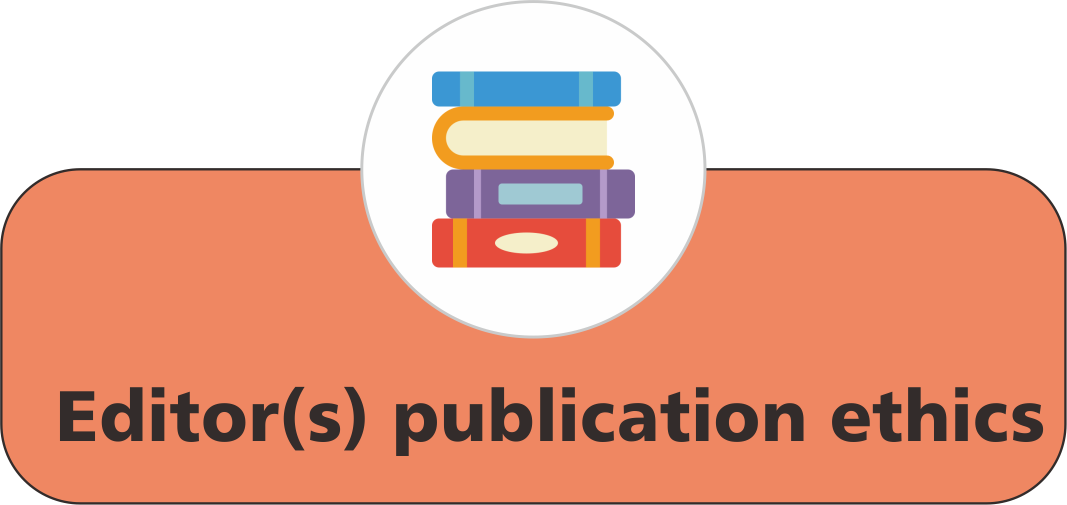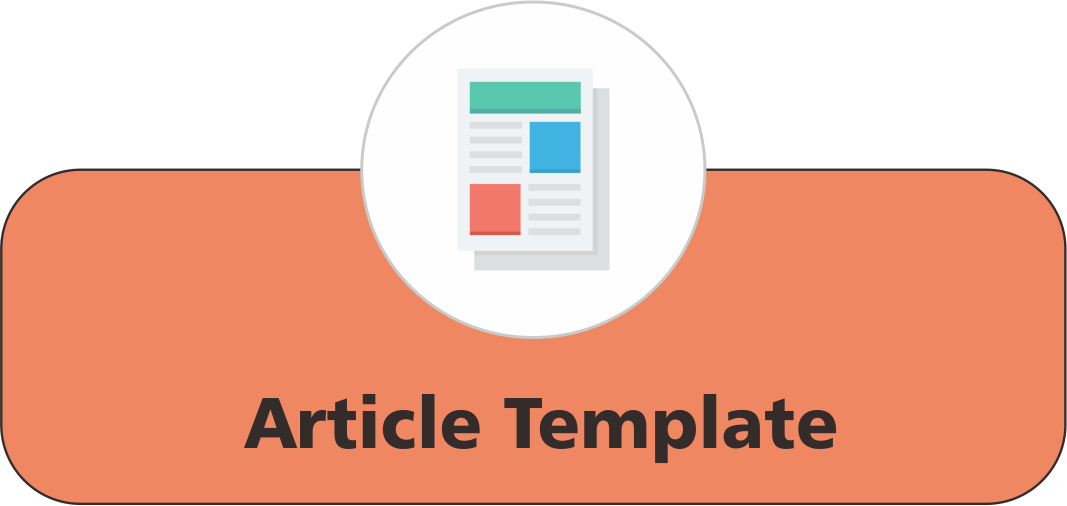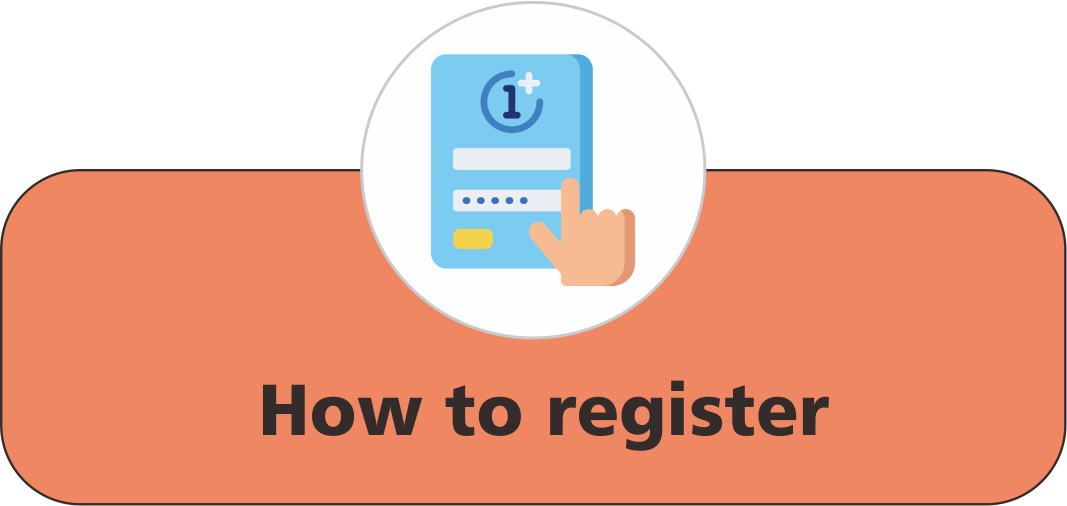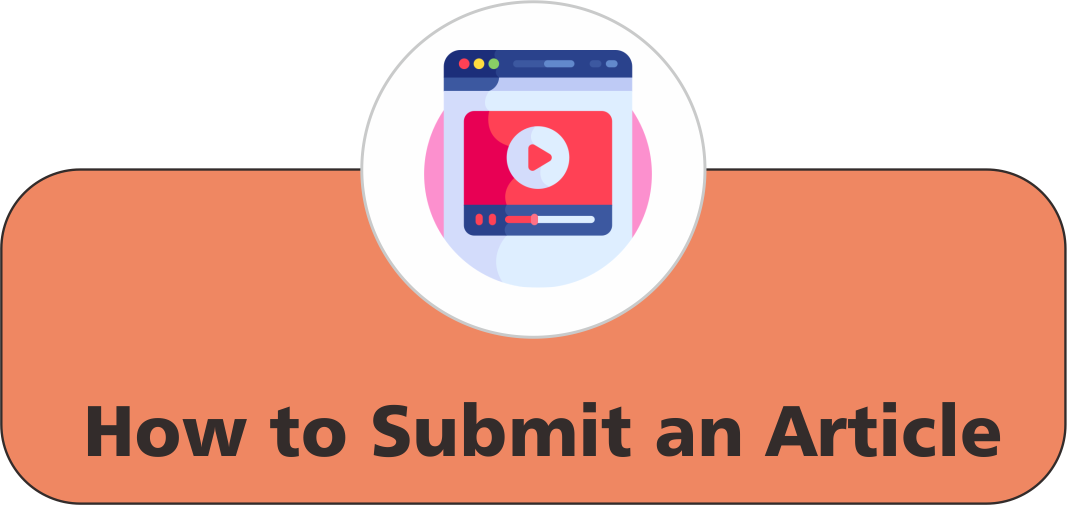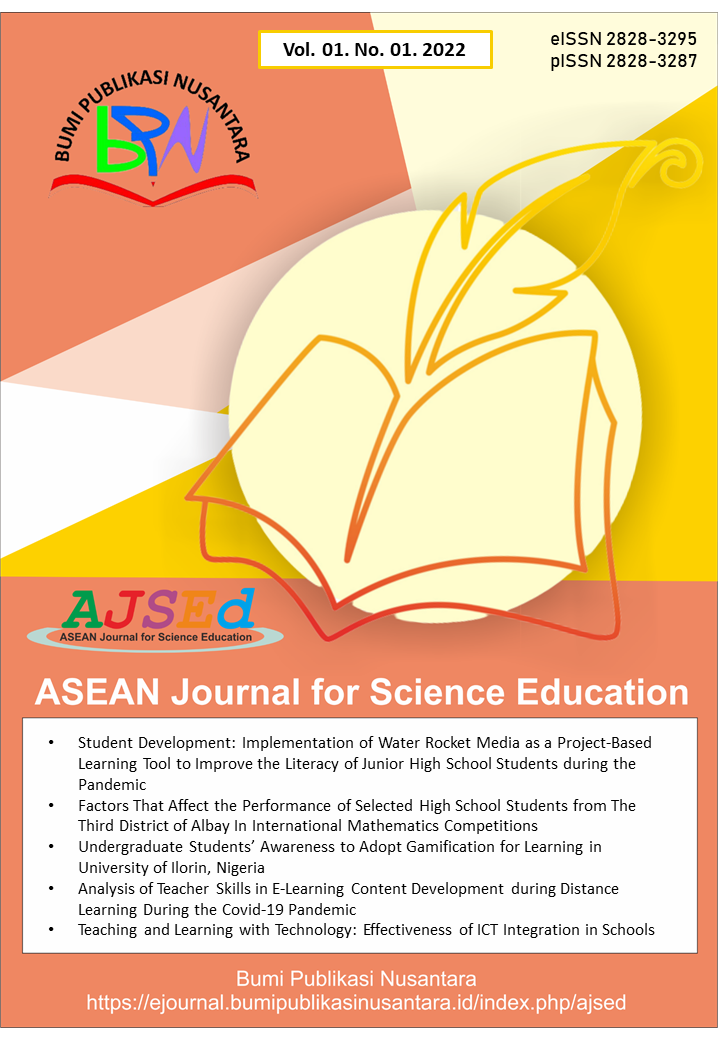Introducing the ASEAN Journal for Science Education (AJSEd) as a Catalyst for Advancing Science Education in Southeast Asia
 ),
),
(1) Yayasan Bumi Publikasi Nusantara
 Corresponding Author
Corresponding Author
Abstract
Keywords
References
Abdussemiu, A. (2022). Problems of teaching practical biology in senior secondary schools. ASEAN Journal of Science and Engineering Education, 2(3), 199-206.
Abulude, F.O., Acha, S., Gbotoso, O.A., Arifalo, K.M., Ademilua, S.O., Bello, L.J., Olayinka, Y.F., and Aladesaye, C. (2022). Environmental education: A tertiary institution’s indoor air quality assessment in Nigeria. ASEAN Journal for Science Education, 1(1), 41-48.
Abulude, F.O., Oluwafemi, M.O., Arifalo, K.M., Elisha, J.J., and Yusuf, A. (2022). Real-time air quality index app: The use of e-weather HDF app for education in monitoring of pollutants and meteorological parameters in Nigeria. ASEAN Journal of Science and Engineering Education, 2(2), 157-162.
Aderele, S.O., and Sanni, T.A. (2022). Undergraduates perception towards the use of Google Classroom for learning. Indonesian Journal of Teaching in Science, 2(2), 117-126.
Agustin, M.I., Muktiarni, M., and Mupita, J. (2022). Implementation of the reading and writing literacy program to elementary school students about the impact of the natural disaster of Mount Merapi. Indonesian Journal of Teaching in Science, 2(2), 99-106.
Ahsan, M., Uzair, M., and Ali, M. (2022). Attitudes and perceptions towards cultured meat among general population in Pakistan. ASEAN Journal of Science and Engineering Education, 2(1), 111-122.
Al Husaeni, D.F., and Nandiyanto, A.B.D. (2022a). Bibliometric using VOSviewer with publish or perish (using Google Scholar data): From step-by-step processing for users to the practical examples in the analysis of digital learning articles in pre and post covid-19 pandemic. ASEAN Journal of Science and Engineering, 2(1), 19-46.
Al Husaeni, D.F., and Nandiyanto, A.B.D. (2022b). Animation for educating, socializing, and giving understanding characteristics of malnourished children. Indonesian Journal of Teaching in Science, 2(2), 147-154.
Al Husaeni, D.N., and Al Husaeni, D.F. (2022). How to calculate bibliometric using VOSviewer with Publish or Perish (using Scopus data): Science education keywords. Indonesian Journal of Educational Research and Technology, 2(3), 247-274.
Ala, N.A., Onojah, A.O., Ishyaku, A.M., and Adamu, S.B. (2022). Development of an animation package in biology for teaching vertebrate, anatomy, and physiology. ASEAN Journal for Science Education, 1(2), 117-130.
Andika, R., and Putra, Z.A. (2022). Teaching programming to chemical engineering students. ASEAN Journal of Science and Engineering Education, 2(1), 51-60.
Anwar, N.B.B., and Minghat, A.D. (2024). Industrial engineering students’ readiness towards industrial revolution 4.0 at technical and vocational university: Literature review. ASEAN Journal for Science Education, 3(1), 95-112.
Arciosa, R.M., Perfecio, J., and Cerado, E.C. (2022). Community extension: Literacy and numeracy enhancement program for alternative learning system and out-of-school youth learners. ASEAN Journal for Science Education, 1(2), 75-80.
Asoy, E., Boston, E., Madagmit, M., and Bacatan, J. (2022). Manipulatives in learning fraction for improving first-year elementary students’ understanding. Indonesian Journal of Teaching in Science, 2(2), 175-182.
Assem, H.D., Owusu, M., Issah, S., and Issah, B. (2024). Identifying and dispelling students’ misconceptions about electricity and magnetism using inquiry-based learning in selected junior high schools. ASEAN Journal for Science Education, 3(1), 13-32.
Asuquo, E.N., Onasanya, S.A., Onasanya, T.O., and Aladesusi, G.A. (2022). Effect Glogster on students’ academic achievement in selected basic technology concepts in Ilorin metropolis. ASEAN Journal of Science and Engineering Education, 2(1), 97-110.
Awofala, A.O.A., and Agbolade, F.O.O. (2024). Effect of peer-tutoring strategy on senior secondary school students’ achievement in mathematics. ASEAN Journal for Science Education, 3(1), 1-12.
Azizah, E.V., Nandiyanto, A.B.D., Kurniawan, T., and Bilad, M.R. (2022). The effectiveness of using a virtual laboratory in distance learning on the measurement materials of the natural sciences of physics for junior high school students. ASEAN Journal of Science and Engineering Education, 2(3), 207-214.
Babalola, E.O., and Omolafe, E.V. (2022a). Construction process of robotic devices to teach aspect of auto mechanic in Nigeria Basic Schools. ASEAN Journal of Science and Engineering Education, 2(1), 123-128.
Babalola, E.O., and Omolafe, E.V. (2022b). Detail experimental procedure for the construction process of robotic devices to teach aspect of auto mechanic. ASEAN Journal of Science and Engineering Education, 2(2), 169-176.
Babalola, E.O., and Omolafe, E.V. (2022c). Effect of developed mobile application on undergraduates academic performance in computer science. ASEAN Journal of Science and Engineering Education, 2(3), 215-222.
Barke, H.D. (2023). Broensted acids and bases: History, misconception, and application today. ASEAN Journal for Science Education, 2(1), 23-32.
Bolaji, H.M. (2022). Information and communication technology as a veritable tool for administrators in university: From teaching perspectives to challenges in education. Indonesian Journal of Teaching in Science, 2(2), 183-192.
Cabanatuan, D., and Ahmad, C. (2022). Permissive parenting style and maladaptive behavioral tendencies among junior high school students of Notre Dame of Tacurong College, Mindanao, Philippines. ASEAN Journal of Science and Engineering Education, 2(1), 87-96.
Cruz, E.D.B., Razon, J., Dayao, J.D., Garcia, K.R.C., Manuel, M.A.M., Tiria, G.C., and Tangcuangco, A.L. (2022). Awareness and acceptability of the university's vision, mission, goals, and objectives in Bachelor of Science in Electrical Engineering program. ASEAN Journal of Science and Engineering Education, 2(3), 253-264.
Dermawan, R., Muktiarni, M., and Mupita, J. (2022). Efforts to increase the interest of junior high school students in mathematics lessons using the TikTok learning tool. ASEAN Journal for Science Education, 1(2), 81-88.
Dwiana, O., Muktiarni, M., and Mupita, J. (2022). Improved information literacy of elementary school students about living pharmacies through information and communication media (ICT). ASEAN Journal of Science and Engineering Education, 2(3), 193-198.
Ekunola, G.T., Babalola, E.O., Omolafe, E.V., and Ibrahim, A.T. (2022). Undergraduate students’ awareness to adopt gamification for learning in University of Ilorin, Nigeria. ASEAN Journal for Science Education, 1(1), 17-22.
Fiandini, M., Hofifah, S.N., Ragadhita, R., and Nandiyanto, A.B.D. (2024). How to make a cognitive assessment instrument in the merdeka curriculum for vocational high school students: A case study of generating device materials about the stirling engine. ASEAN Journal for Science Education, 3(1), 65-86.
Glushchenko, V.V. (2024). The paradigm of curriculum differentiation in higher IT education. ASEAN Journal for Science Education, 3(1), 87-94.
Ibrahim, M.M.M., and Nandiyanto, A.B.D. (2022). Education on the importance of food consumed by breastfeeding mothers and exclusive breastfeeding against stunting prevention through PowerPoint media. ASEAN Journal for Science Education, 1(2), 103-112.
Idris, A.M., Arah, A.S., and Abd-El-Aziz, A.A. (2023). Barriers and measures for enhancing the conduct of transformative research among industrial and technology education lecturers and postgraduate students in university. ASEAN Journal for Science Education, 2(1), 39-46.
Jadhav, P., Gaikwad, H., and Patil, K.S. (2022). Teaching and learning with technology: Effectiveness of ICT integration in schools. ASEAN Journal for Science Education, 1(1), 33-40
Jose, M.T.N.S. (2022). Factors that affect the performance of selected high school students from the third district of Albay in International Mathematics Competitions. ASEAN Journal for Science Education, 1(1), 9-16.
Joshua, A.B., Olabo, O.O., Ochayi, O.A., Musiliu, A.A., and Aderogba, O.A. (2022). Barriers limiting the use of Google Classroom for learning vocational and entrepreneurship courses. ASEAN Journal of Science and Engineering Education, 2(1), 61-74.
Juhanaini, J., Sholihat, L.F., Maryanti, R., Budiman, R.A., and Armindony, F.F. (2022). Media learning patch board in science learning energy change materials for children with intellectual disabilities. Indonesian Journal of Teaching in Science, 2(2), 139-146.
Lagcao, Y.G.D., Dechavez, J.P.A.D., Goleng, D.J.G., Lagca, Y.G.D., Tangkli, K.Y.M., and Vicera, W.J.C. (2023). Math readiness and its Effect on the online academic performance of science, technology, engineering, and mathematics students. ASEAN Journal for Science Education, 2(1), 33-38.
Minghat, A.D., Abdullah, N.A., and Suparman, S. (2022b). The challenges of remote e-assessments during COVID-19 outbreaks among undergraduate engineering programs. ASEAN Journal of Science and Engineering Education, 2(3), 229-232.
Minghat, A.D., Mustakim, S.S.B., and Shahroni, N. (2022a). Literature review: Technical and vocational education and training (TVET) in Malaysia. ASEAN Journal for Science Education, 1(2), 89-102.
Mohammed, S.R. (2023). Quantitative analysis of the problems and prospects of the Nigerian industrial sector in the 21st century. ASEAN Journal for Science Education, 2(1), 55-56.
Nafsi, N.R.R., and Maryanti, M. (2022). Analysis of teacher skills in e-learning content development during distance learning during the COVID-19 pandemic. ASEAN Journal for Science Education, 1(1), 23-32.
Nelvarina, N., Agustina, T.W., and Solikha, M. (2024). Can the inquiry learning model improve students' system thinking skills?. ASEAN Journal for Science Education, 3(1), 55-64.
Ngag, C.J.E., Aquino, I.D.P., Satur, K.M.C., Morbo, E.A., and Calixtro Jr, V.L. (2022). Earthquake disaster preparedness for students of junior high school. ASEAN Journal of Science and Engineering Education, 2(2), 137-142.
Nordin, N.A.H.M. (2022). A bibliometric analysis of computational mapping on publishing teaching science engineering using VOSviewer application and correlation. Indonesian Journal of Teaching in Science, 2(2), 127-138.
Nueva, J., Tanaleon, J.A., and Besa, A. (2022). Rice tariffication law: Education and views of farmers in the Southern Philippines. ASEAN Journal of Science and Engineering Education, 2(2), 143-146.
Nugroho, H. (2022). Constructive alignment approach for capstone project with industry involvement: Case study in Malaysia University. ASEAN Journal of Science and Engineering Education, 2(1), 37-50.
Nurfalah, I., Maryanti, R., Wulandary, V., and Irawan, A.R. (2022). Earthquake disaster mitigation explanation to prepare a disaster response generation for students in 3th-grade of elementary school. ASEAN Journal of Science and Engineering Education, 2(2), 147-152.
Octaviani, H., Sakti, A.W., and Bilad, M.R. (2022). Improving activities and learning outcomes of elementary school students through experimental methods using lime as an alternative electrical energy source during the COVID-19 pandemic. ASEAN Journal for Science Education, 1(2), 63-74.
Olumorin, C.O., Babalola, E.O., and Ayoola, D.A. (2022). Design and development of human excretory system model to teach a biology concept in Ilorin, Nigeria. Indonesian Journal of Teaching in Science, 2(2), 107-116.
Padmore, E.A., and Ali, C.A. (2024). Exploring effective differentiated instruction in the teaching and learning of mathematics. ASEAN Journal for Science Education, 3(1), 41-54.
Pandoy, L.K.L., Diaz, Z.O.M.H., Salem, K.J.G., Damaso, J.M., Cabaylo, R.M., and Abo, C.P. (2022). Science teachers’ lived experiences and challenges during covid-19 pandemic. Indonesian Journal of Teaching in Science, 2(2), 155-174.
Pangestu, T.I., and Sakti, A.W. (2023). Learning color theory in elementary school using basic infographic media during the COVID-19 pandemic. ASEAN Journal for Science Education, 2(1), 1-6.
Phansori, N., Phukrongta, S., Kriamthaisong, O., and Kenpankho, P. (2022). Study the relationship of earthquake and ionosphere using IRI TEC for education. ASEAN Journal of Science and Engineering Education, 2(2), 153-156.
Prabowo, T.T., and Suroso, D.J. (2022). Indonesian public response to online learnings during the COVID-19 pandemic: An analysis of social media. Indonesian Journal of Teaching in Science, 2(2), 193-206.
Putra, R.D., and Sakti, A.W. (2022). Student development: Implementation of water rocket media as a project-based learning tool to improve the literacy of junior high school students during the pandemic. ASEAN Journal for Science Education, 1(1), 1-8.
Ramachandran, B., Ramanathan, C., and Khabou, M. (2022). A case study at the University of West Florida on improving recruitment and retention of female students in engineering. ASEAN Journal of Science and Engineering Education, 2(3), 233-252.
Rusyani, E., Maryanti, R., Rahayu, S., Ragadhita, R., Al Husaeni, D.F., and Susetyo, B. (2022). Application of Scrabble game in improving learning of simple sentence structure on the student with hearing impairment. ASEAN Journal of Science and Engineering Education, 2(1), 75-86.
Saadu, U.T., Obafemi, K.E., Olaniyan, A.O., Sulyman, H.T., Ajayi, O., and Abubakar, A.Y. (2024). Retaining female students in school: Intervention for improving menstrual hygiene. ASEAN Journal for Science Education, 3(1), 33-40.
Shabudin, N.A.B., Wahab, N.B.A., Zamanhuri, M.A.B., and Rosli, A.H. (2022). 3D simulation of muscular system in anatomy learning. ASEAN Journal for Science Education, 1(2), 113-116.
Shah, S.S. (2022). A study on attitude of urban and rural college students towards science. ASEAN Journal of Science and Engineering Education, 2(2), 177-182.
Shahroni, N., Minghat, A.D., and Mustakim, S.S.B. (2022). Methodology for investigating competency index of technical vocational education and training (TVET) instructors for 4.0 industrial revolution. ASEAN Journal for Science Education, 1(1), 49-62.
Strömberg, L.J. (2022). Models for interactions in boundary layers at rotational motions in noncircular orbits: The concept for teaching science. ASEAN Journal of Science and Engineering Education, 2(3), 223-228.
Swafiyah, B., Muhammad, B.A., and Yamusa, A.Z. (2023). Effect of conceptual change instructional strategy on chemistry students' performance in acids and bases concepts. ASEAN Journal for Science Education, 2(1), 47-54.
Tipmontiane, K., and Williams, P.J. (2022). The integration of the engineering design process in biology-related STEM activity: A review of Thai secondary education. ASEAN Journal of Science and Engineering Education, 2(1), 1-10.
Wahab, N.A., Mahmood, N.H.N., and Minghat, A.D. (2023). Science education research methodology: A case study investigating the correlation between construction, safety, accident, and the effectiveness Construction Industry Development Board (CIDB) Green Card Training Program. ASEAN Journal for Science Education, 2(1), 7-16.
Widdyusuf, L., Muktiarni, M., and Mupita, J. (2022). Earthquake disaster preparedness for students of junior high school. ASEAN Journal of Science and Engineering Education, 2(2), 129-136.
Wijaya, H., Maryanti, R., Wulandary, V., and Irawan, A.R. (2022). Numerical minimum competence assessment for increasing students’ interest in mathematics. ASEAN Journal of Science and Engineering Education, 2(3), 183-192.
Wirzal, M.D.H., and Halim, N.S.A. (2022). Short play approach for analytical chemistry class. ASEAN Journal of Science and Engineering Education, 2(2), 163-168.
Yolanda, Y.D., and Nandiyanto, A.B.D. (2022). How to read and calculate diameter size from electron microscopy images. ASEAN Journal of Science and Engineering Education, 2(1), 11-36.
Zahra, P.R., and Nandiyanto, A.B.D. (2023). Learning of objects, elements, compounds, and mixtures in daily life’s elementary school students. ASEAN Journal for Science Education, 2(1), 17-22.
Article Metrics
Abstract View : 218 times
: 218 times Download : 78 times
Download : 78 times
Refbacks
- There are currently no refbacks.
Copyright (c) 2025 Bumi Publikasi Nusantara

This work is licensed under a Creative Commons Attribution-ShareAlike 4.0 International License.



